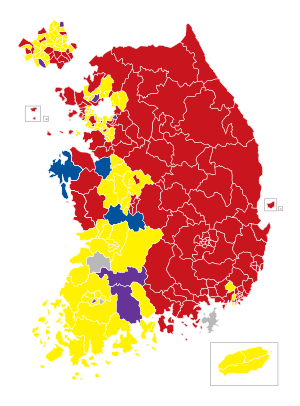General election in South Korea 2012
The parliamentary elections in South Korea took place on April 11, 2012. The South Korean people voted on the composition of the South Korean National Assembly (Gukhoe) with 300 seats. 246 MPs were elected directly in the constituencies, 54 on a proportional basis via party lists. The ruling conservative Saenuri party was able to defend its absolute majority despite losses.
Campaign issues
The official election campaign began on March 29, 2012. According to reports from international media, the issue of North Korea hardly played a role. Instead, the election campaign revolved around economic, educational and social policy issues such as inflation, economic growth, the increasing income gap and the high cost of housing and training. In the opinion polls in the months leading up to the election, President Lee Myung-bak's ruling Conservative Saenuri party fared significantly worse than the liberal opposition parties. The president was credited with having brought South Korea out of the international financial and economic crisis much faster with his economic policy , but he and the politics represented by his party were accused of social coldness and harshness. The party leader of the Saenuri party Park Geun-hye therefore concentrated her election campaign primarily on the aforementioned social and educational issues.
Park Geun-hye (박근혜)
Saenuri party
Results
| Political party | Abbreviation | Alignment | Constituencies | Proportional representation |
Total seats |
|||||
|---|---|---|---|---|---|---|---|---|---|---|
| be right | Be right (%) | Seats | be right | Be right (%) | Seats | |||||
|
Saenuri Party 새누리 당 New World Party |
SP | conservative | 9,324,911 | 43.3% | 127 | 9,129,226 | 42.8% | 25th | 152 | |
|
Minju-tonghap Party 민주 통합 당 United Democratic Party |
MTP | liberal | 8,156,045 | 37.9% | 106 | 7,775,737 | 36.5% | 21st | 127 | |
|
Tonghap jinbo party 통합 진보당 United Progressive Party |
TJP | Left | 1,291,306 | 6.0% | 7th | 2,198,082 | 10.3% | 6th | 13 | |
|
Jayu-seonjin Party 자유 선진 당 Liberal Progressive Party |
YES | conservative | 474.001 | 2.2% | 3 | 689.843 | 3.2% | 2 | 5 | |
|
Jinbo-sin Party 진보 신당 New Progressive Party |
JIP | Left | 101,614 | 0.5% | 0 | 242.995 | 1.1% | 0 | 0 | |
|
Gungmin Saenggak Party 국민 생각 National Thought Party |
GSP | conservative | 44,379 | 0.2% | 0 | 156.222 | 0.7% | 0 | 0 | |
|
Changjo-hanguk Party 창조 한국당 Creative Korea Party |
CHP | liberal | 3,624 | 0.0% | 0 | 91,875 | 0.4% | 0 | 0 | |
| Other parties | - | 132,709 | 0.6% | 0 | 1,125,495 | 5.0% | 0 | 0 | ||
| Independent candidates | 2,016,737 | 9.4% | 3 | - | 3 | |||||
| Overall result | 21,545,326 | 100% | 246 | 21,327,600 | 100% | 54 | 300 | |||
- Results by constituency
Saenuri Party (SP)
Minju-tonghap Party (MTP)
Tonghap jinbo party (TJP)
Jayu seonjin party (JAP)
The turnout was 54.3% and was thus significantly higher than in the last election , when it was only 46.0%. As a result, the ruling Saenuri party achieved an election victory despite significant losses and won a very narrow majority of 152 of the 300 parliamentary seats. This success of the Saenuri party was surprising to this extent and was unthinkable a few months before the election. It is largely due to the popularity and election campaign of party leader Park Geun-hye , who has good prospects of being nominated as the top candidate of her party for the upcoming presidential elections this year. The leaders of the Jayu-seonjin party Shim Dae-pyong and Minju-tonghap party Han Myung-sook resigned from their posts following the opposition parties' defeat . The conservative Saenuri party achieved its best results in the eastern parts of the country, the party for Jayu-seonjin achieved its best results with more than 20% of the vote in the western province of South Chungcheongnam , while the liberal and left parties their main focus rather in the south and west of the country.
Less than two weeks after the election, the Saenuri party lost its absolute majority when two MPs left the party. Kim Hyung-tae resigned on allegations of sexual harassment, and Moon Dae-sung faced plagiarism allegations regarding his dissertation. This means that the Saenuri party only has 150 seats out of 300.
Web links
- Opinion poll on the general election in April. In: KBS World Radio. March 5, 2012, Retrieved April 5, 2012 .
- The turnout for Koreans abroad is 45 percent. In: KBS World Radio. April 3, 2012, Retrieved April 5, 2012 .
Individual evidence
- ↑ Official campaign for parliamentary elections has started. In: KBS World Radio. April 1, 2012, Retrieved April 5, 2012 .
- ↑ South Korea votes in closely contested poll. In: Al Jazeera . April 11, 2012, accessed April 13, 2012 .
- ^ The South: Busy at the polls. In: Asia Times. April 2, 2012, accessed April 13, 2012 .
- ↑ Surprise victory for conservatives - ruling party wins parliamentary election in South Korea. In: focus. April 12, 2012, Retrieved April 13, 2012 .
- ↑ LFP boss resigned due to election defeat. In: KBS World Radio. April 12, 2012, Retrieved April 13, 2012 .
- ↑ DUP boss Han Myung-sook resigns due to electoral defeat. In: KBS World Radio. April 13, 2012, Retrieved April 13, 2012 .
- ↑ Elected MP Kim resigns from ruling party due to scandal. In: KBS World Radio. April 18, 2012, Retrieved April 22, 2012 .
- ↑ With the resignation of Moon Dae-sung, SP loses an absolute majority. In: KBS World Radio. April 20, 2012. Retrieved April 22, 2012 .







